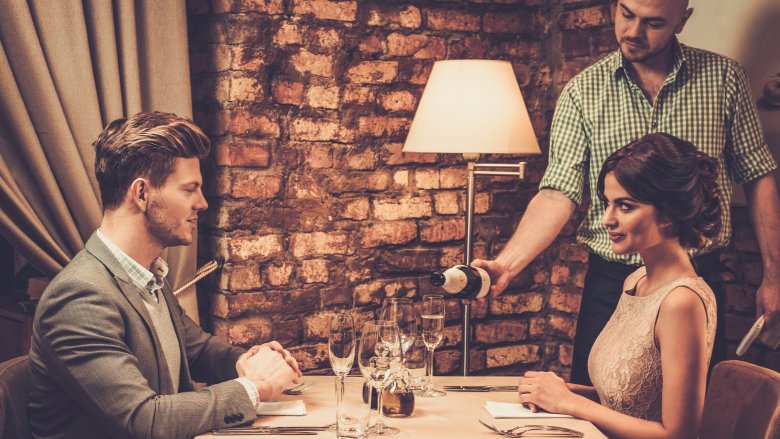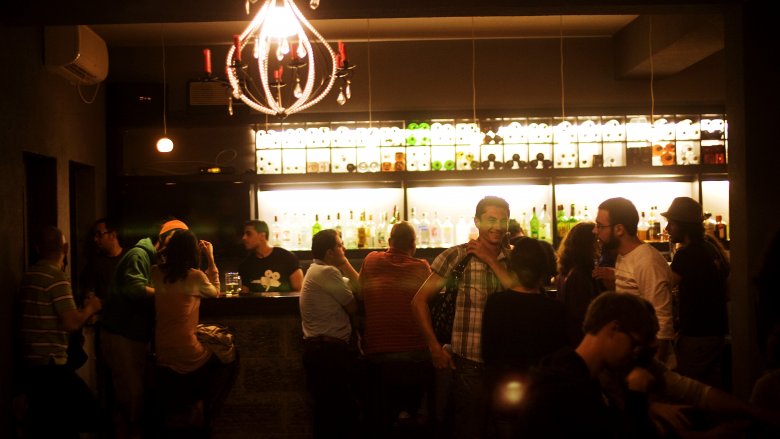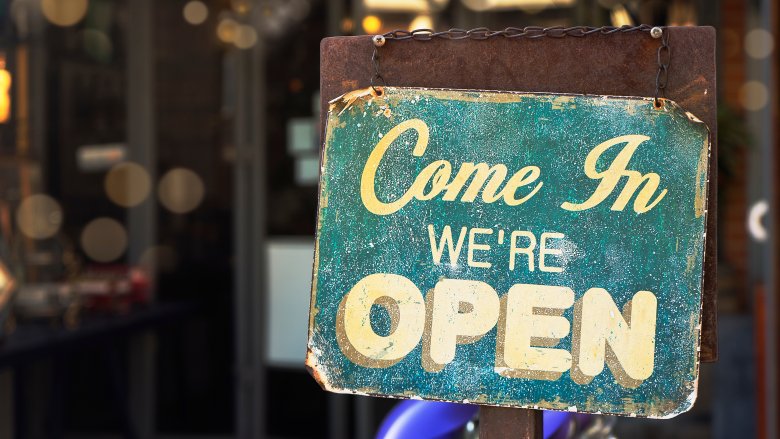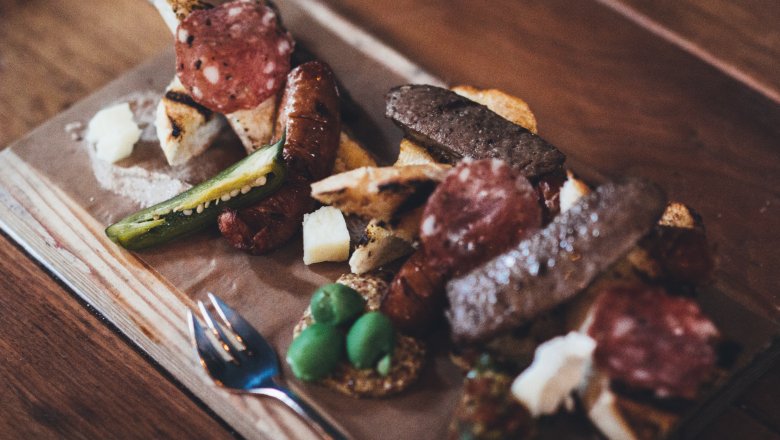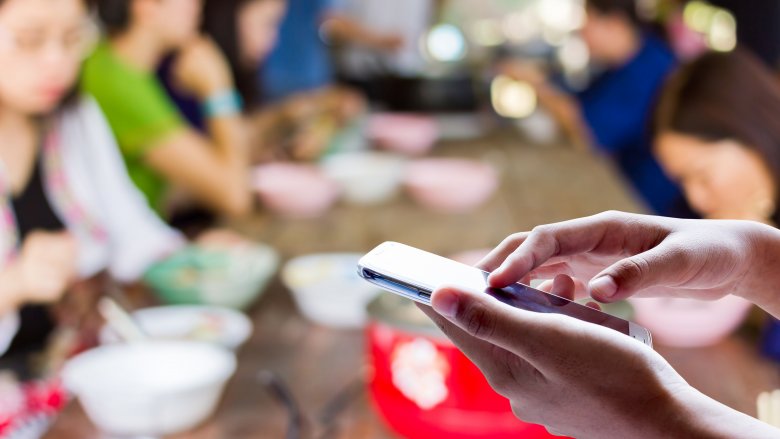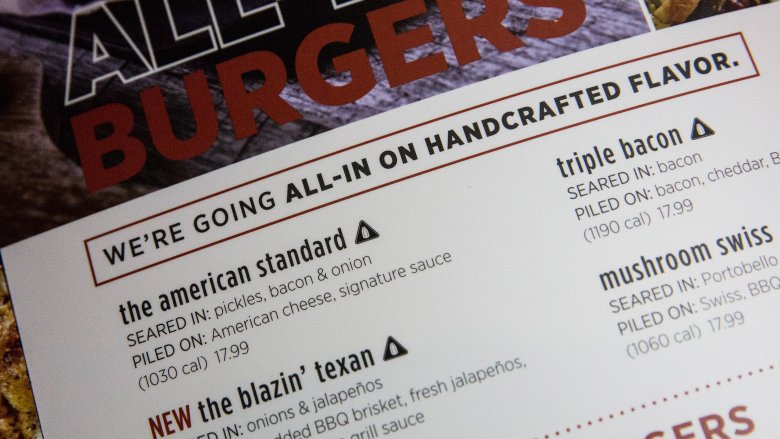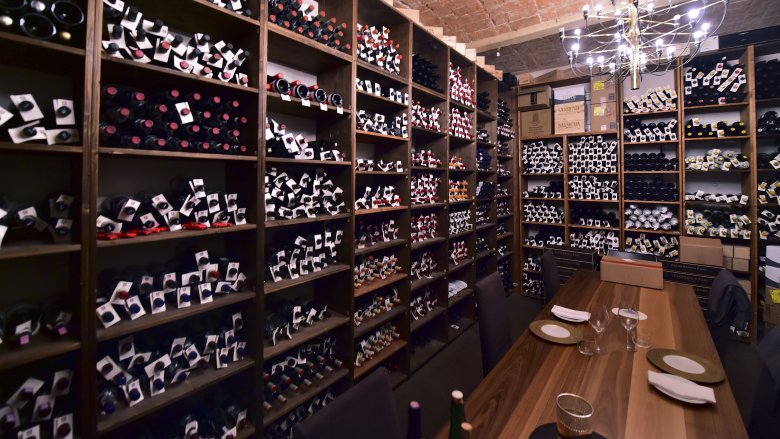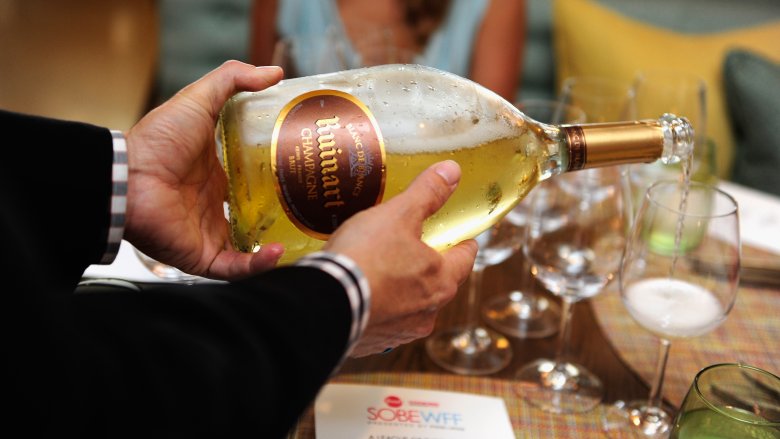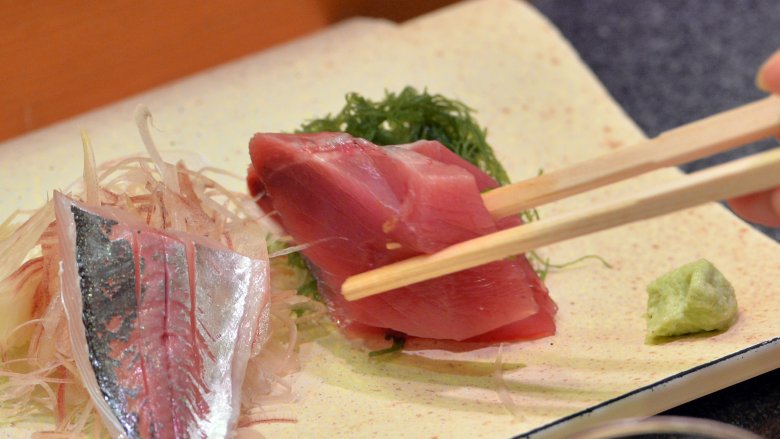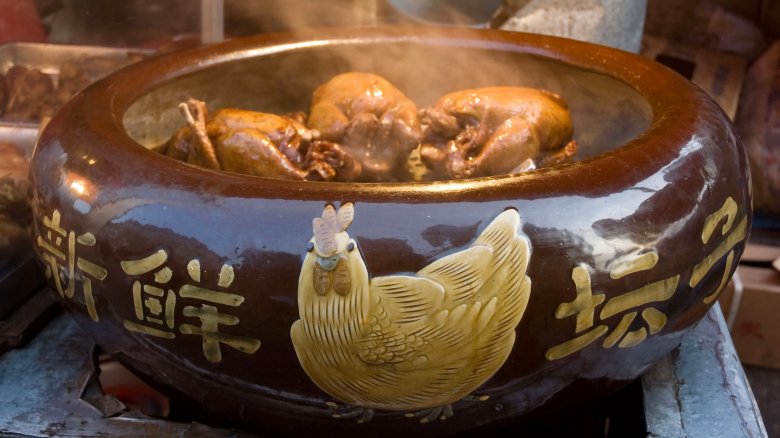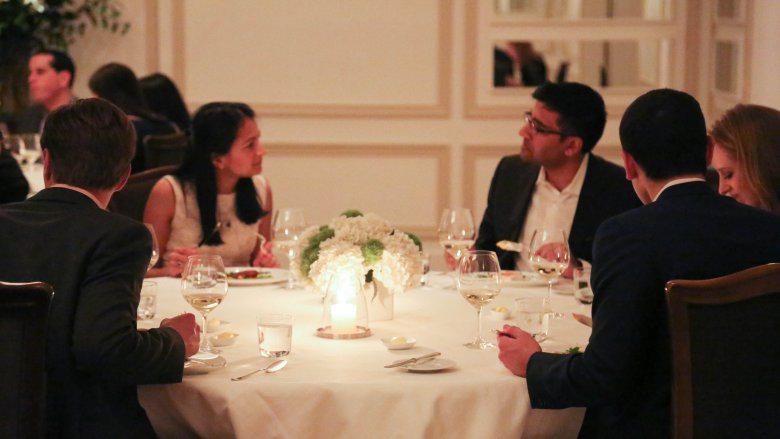Restaurant Hacks You Need To Know About
As a veteran food writer, I've got a list of tips and tricks for dining out a mile long. For instance, the answer to the question "Have you dined with us before?" is always "Yes." (True or not, whatever spiel about sharing small plates they're fixing to lay on me is sure to be self-evident; better to spare the server the chore of reciting it and myself the chore of listening to it.) The answer to "How would you like that prepared?" is always "Whatever the chef suggests." (If I wanted it the way I wanted it, I'd make it at home.) And the best dish to order in an immigrant-run restaurant is always the one the waitstaff looks most uncomfortable discussing with me. (I don't always like it, but I always learn something about the cuisine in question, which for my purposes is just as valuable.)
Your mileage may vary with respect to those guidelines — but here are some that I can guarantee work for everyone.
Sit at the bar
Tables are for amateurs. Sorry not sorry, but that's the blunt consensus among professional food writers — who've got the facts to back up their strong preference for dining at the bar.
One selling point is sheer ease. A, you're more likely to score a seat without a reservation. B, you're freer to relax, linger, and order as you wish, whereas tables are implicitly reserved for full meals with a clear endpoint. And C, as The Atlantic quotes San Francisco Chronicle restaurant critic Michael Bauer, you "generally get better service at the bar than at a table; it seems someone is always in front of you and can — and does — monitor your progress."
Another benefit is social (or, for that matter, antisocial) expediency. If you're on a date, The Atlantic points out, you get to sit inches from your companion rather than all the way across the table. If you're a party of one, you can chat up the person next to you or relish your alone time while avoiding "the very real stigma solo diners feel" in the dining room.
And yet another is a matter of tradition, depending on the type of establishment. To sit at a table in, say, a sushi bar or a raw bar — the operative word being "bar" — is to miss out on all the action and interaction, the fish slicing and oyster shucking and such, which is half the fun of the experience. So belly on up already.
Dine off-peak
Maybe you're too cool to flock with the early birds who tend to frequent restaurants in the afternoon lull between lunch and dinner, but we professional eaters aren't. On the contrary, many of us prefer eating in the relative peace and quiet of the off-peak hours. As with bar dining, there's no wait for a seat, and no particular expectation regarding meal size, which means less pressure to order an entree and greater freedom to graze. In addition, the service is less rushed and therefore more able and willing to answer our endless questions about this or that dish preparation. It all makes for a leisurely experience we come to appreciate even when we're not on the clock — a sort of staycation in the midst of the average workday.
Not to discount the early-bird discounts: The fact that sweet deals happen to abound between the hours of 2 and 6 p.m. is a major bonus. Put it all together, and you could argue that breaking bread with the seniors and toddler-toters is so knowingly uncool it's actually super-cool. By all means wear granny glasses and black socks with loafers to make the ironic point — you're an industry hipster now.
Save your splurges for the good stuff
Unless you're both extremely rich and extremely thin — in which case you've already hacked life itself and don't need our advice on anything — you're probably dining out on some sort of budget. Be it calories or cold hard cash, you've got to make it count, right? Right. So why waste an ounce or dime on a supermarket-grade experience?
Take charcuterie boards. They've been all the rage for years now — and when meticulously assembled with house-cured meats and/or high-quality imports you can't easily come by elsewhere, they're delightful. Not so much a plate of mass-produced cold cuts with all the artisanal cred of Oscar Mayer and Boar's Head.
The same goes for baked goods, starting with the bread basket. If those loaves are hand-crafted, fresh from the oven, and accompanied by first-rate butter or olive oil, knock yourself out. But spoiling the chef-prepared meal you came to have on flavorless packaged rolls is grimly pointless, like going on vacation only to spend most of it in the hotel room.
As for sweet treats, this Paste article points out, many restaurants without dedicated pastry chefs "offer a few homemade desserts and buy the rest." Rather than defeat the whole purpose of splurging by settling for a slice of chocolate cake that was trucked in from a distribution warehouse three days ago, ask what's prepared on-premises — and if you get the wrong answer, order a nice glass of dessert wine or liqueur instead.
Use a translation app
Sure, it can be a little off-putting to sit down at a Chinese restaurant filled with the convivial hum of regulars sharing hot pots and platters piled high with roast meats or hand-cut noodles, only to be greeted with the wordless dropoff of an English-language menu listing the same 20 Westernized dishes you could get at Panda Express. But don't take it personally — your server's just playing the odds. How much money would you bet on your average American to waltz in and order, say, fuqi feipian (beef innards in chili sauce) in fluent Mandarin?
Prevalent as the two-menu system may be in the US, this Today article suggests it's easy enough to beat: Politely request the Chinese-language version, then ask the staff or your fellow patrons for recommendations. Which begs the obvious question — what if no one in the joint speaks English?
Technology to the rescue. Though the Google Translate app remains far from perfect, it's getting better all the time; just ask my colleague Mark Antonation, food editor for Denver alt-weekly Westword, who relies on it often. By way of example, he mentions a recent outing when "it successfully identified an uncommon herb called shepherd's purse, which turned out to be delicious!" And even its failures count as victories for sheer amusement's sake — Antonation still hasn't figured out what "characteristics of gluten-fried vegetarian Buddhist" might be, but he's pretty sure it's not legal stateside. In short, the app's a charming dinner companion whether it's working or not.
Peruse the menu with a critical eye
Sometimes, even English-language menus require a knack for translation, namely into adspeak. According to graphic-design website Canva, "Menu engineers study the visual and verbal psychology behind why people order certain items — and use that valuable information to design menus in a way that maximizes profits." Read: They're manipulating you to spend big.
For instance, research shows that diners tend to eyeball the upper right-hand corner of a menu first. So guess where the most expensive dishes usually appear? It also shows that red and blue hues stimulate the appetite. So guess which colors might be employed to highlight the priciest items? And it shows that we pay less attention to prices when they're a) "buried" in text rather than formatted into columns for easy comparison; b) presented without dollar signs; and c) not rounded to the nearest dollar. So guess which you're more apt to buy?
Crazy-awesome steak $50.00
Crazy-awesome steak blah blah blah blah blah blah blah awesome blah blah blah blah blah blah awesome 49.95
Finally, the research shows that vivid dish descriptions drive sales significantly. Instead of "blah blah blah," think:
Hand-cut, grass-fed, bone-in filet, charbroiled to perfect perfection and bedaubed with your choice of glitter sauce or unicorn milk 49.95
So the next time you dine out, read between the lines and ask yourself: Do I really want that pickled lutefisk with frankincense and myrrh, or are the bad guys just brainwashing me to want it?
Find the hidden gems on the wine list
In the early stages of the incurable condition known as enophilia, you know just enough about wine to be painfully aware of just how much you don't know, but you're not yet ready to commit your life savings to your education. Until the disease spreads and you don't have a choice, you're sticking to familiar, cheap-but-not-too-cheap, "safe" pours.
Wine Enthusiast explains why that's the wrong tack to take. For one thing, most restaurant beverage programs "follow a graduated markup, with the highest markups on the cheapest wines and lower markups on higher-end wines" — which means you actually get better bang for your back by spending extra. (In fact — in the one exception to the markup rule — the second-cheapest bottle on the list is usually the worst value, on the grounds that people only order it so as to seem less tight-fisted.) For another, bar managers tend to price the geeky, lesser-known wines they're passionate about more reasonably than the household brands, which will "sell no matter what."
So from a quality-to-cost perspective, you're best off taking a chance on a new discovery in the mid-to-upper price range. Skip the Pinot Grigio, try the Assyrtiko; skip the California Cab, try the Lagrein. And steel yourself for the inevitable progression of wine-lovers' syndrome.
When in doubt, order Champagne
Like sewing on a button and making a spreadsheet,* choosing a bottle of wine for the table is just one of those things every adult should know how to do. But to a novice, even the most straightforward wine-and-food pairing guidelines can prove maddeningly complicated, involving as they do a byzantine array of variables — weight, tannins, sugar, acid, fat, umami, et cetera — and what seem to be more exceptions to the rules than there are rules. Even the old chestnut about whites with fish and reds with meat has its pitfalls.
Good thing there's a solution to this major First World problem: Champagne. Due to its high acidity, low alcohol, and palate-cleansing bubbles — food-friendly qualities and all — it's the "default choice" of many a sommelier tasked with recommending a single wine for a multitude of dishes. Burgers? Sure. Barbecue? Totally. Spicy Chinese or Indian entrées? No sweat (so to speak). Fried chicken? Hell yes. And oysters, of course. And lobster, of courser. And dessert to boot.
To answer your actual questions with more rhetorical questions: Expensive? OK, yeah. Worth it for the sake of foolproof convenience, never mind its own intrinsic beauty? Definitely. Enough said.
*For the record, I can't do either of these things.
Keep calm and have the fish
No fish on Mondays. No oysters in months whose names don't contain the letter "r." No sushi ever, unless you're down with tapeworms. The horror stories that surround seafood consumption are endless. They're also frequently overblown. Not without caution, but we'll give the benefit of the doubt to the fishmongers over the scaremongers.
Let's start with the rumor spread by none other than Anthony Bourdain, who famously wrote in Kitchen Confidential that the seafood sold in restaurants on Mondays wasn't fresh enough for consumption. Now he admits that (as Lifehacker puts it) "his advice was strictly for the New York City market" based on its delivery schedules, not a universal rule — and that, even there, times have changed since the book's publication: "They can't get away with serving us the crap they used to."
The seasonal prohibition on oysters, meanwhile, made sense when farming was less prevalent and industry regulations less strict: Per this Kitchn article, summertime is not only when oysters spawn, affecting their flavor for the worse, but also when a toxic algae that they're prone to absorb blooms. Today, though, careful breeding and monitoring ensure that they're edible year-round.
And about those nasty tapeworms: Sushi chefs rest their reputations on the pristine sourcing, proper storage, and immaculate handling of safe-to-eat, flash-frozen product. So unless you're scarfing down rolls from some back-alley shack called Cheapo Sketchy Sooshi on a daily basis, you can probably (to quote Bourdain) "eat the damn fish."
Keep calm and get the chicken too
It's undercooked. It's overcooked. It's overpriced. It's boring. We agree with the chefs quoted here and here that all of these things can be true of chicken — but none of them have to be.
In calling chicken a "litmus test" for professional chefs, Eater critic Bill Addison voices a long-held truism among food writers that the ability to transform your basic bird into something special is a hallmark of culinary skill. The ultimate case in point: French bistro–style poulet rôti. Done right, roast chicken's a triumph of deceptive simplicity, from its crackling golden-brown skin to its juicy, supple, mildly sweet flesh.
But celebrated examples abound the world round. Peru has its pollo a la brasa, Jamaica its jerk, India its tandoori, Singapore its Hainanese chicken rice, Hungary its paprikash, Senegal its yassa au poulet, the American South its chicken and dumplings — the list of classics goes on and on. (And we're not even counting fried fowl, be it Nashville hot, Sichuan la ji zi, Japanese karaage, or Korean yangnyeom dak, because nobody's ever mad at that.)
What do all these dishes have in common? The obvious: fat. Not one presses boneless, skinless grilled breast into service as a dull, dry, depressing token of self-deprivation. So as long as you're ordering for chicken for its flavor rather than its dietary utility, the restaurant world can be your oyster. (In fact, if you're lucky, it can be your chicken oyster.)
Don't wing it for Restaurant Week
It was supposed to be a win-win. Restaurant Week launched in New York way back in 1992 as a scheme for operators to "increase foot traffic during what's normally a slow time of year," writes Time, by making diners an offer they couldn't refuse — bargains on great meals. Theoretically, the discounts would pay for themselves not only in the short term of high-volume sales but in the long term, as first-time customers became loyal regulars.
But as the promotion took off, it became something of a victim of its own success, and today the win-win looks to many like a whine-whine lose-lose. On the one hand, says New Food Economy, it's "like the food industry's answer to Black Friday," as hordes of cheapskates descend on dining rooms to pick them clean before leaving — with no intention of ever returning — a tip unequal to the worth of their meal. On the other hand, as chefs cut corners accordingly, guests who arrive in the good faith of finding their next home-away-from-home depart disappointed instead by uninspired meals of green salad, salmon, and crème brûlée they could have had at a business convention.
For those in the latter camp, The Financial Diet has sound advice: "Only go to high-end restaurants," and "always look up the menu beforehand" to ensure it actually interests you. That way you're guaranteed both a good value and a good time — and, potentially, a new special-occasion favorite. (Tip well, and you'll be welcomed back with open arms.)
